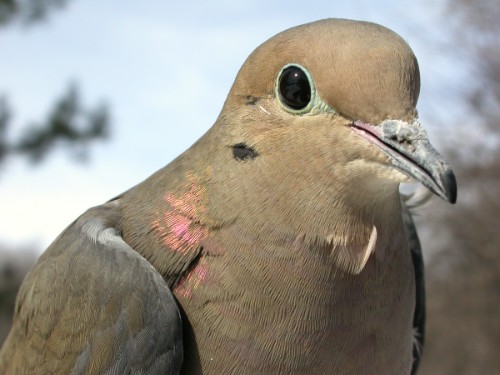|
|
|
WINTER
POPULATION MONITORING |
|
Week 11: Mar 14 - Mar 20, 2005 |
Welcome
to the McGill Bird Observatory weekly report. Click
here for a complete listing of our archives. Comments or questions are welcome at mbo@migrationresearch.org.
|
PICTURE OF
THE WEEK: |
|

This Mourning Dove was
only the second one banded at MBO. While the bluish
tinge to the crown wasn't particularly strong, the distinct rose
colouration on the
throat was enough to lead us to believe it is a male. (Photo by Marcel Gahbauer)
|
| |
THIS
WEEK |
WINTER
TOTAL |
YEAR
TOTAL |
SITE
TOTAL |
| #
birds (and species) banded |
14
(6) |
240
(14) |
46
(10) |
964
(49) |
| #
birds (and species) repeat |
9
(2) |
107
(9) |
32
(2) |
210
(17) |
| #
birds (and species) return |
5
(1) |
9
(3) |
9
(3) |
11
(4) |
| #
species observed |
20 |
36 |
26 |
138 |
| #
net hours |
20.0 |
103.0 |
51.0 |
1025.5 |
| #
birds banded / net hour |
70.0 |
232.0 |
90.2 |
93.9 |
|
|
Note: table does
not include nocturnal banding (owls) |
Bander-in-charge:
Marcel Gahbauer
Banding assistants: Eric Boodman, Averill Craig, Shawn Craik, Christina Donehower,
Gay Gruner, Marie-Anne Hudson, Noemie Laplante, Betsy McFarlane, Arnaud Tarroux
Notes:
For the first time in a long while, we were able to band twice this
week. Perhaps spring is on the way after all, though MBO remains
very much snow-covered. At least the American Goldfinches are an
indicator of the changing seasons, with patches of vivid yellow feathers
moulting in. Three new species for the year were observed this week:
Ring-billed Gull, Cedar Waxwing and Red-shouldered Hawk. Still none
of the more traditional signs of spring though, such as American Robin,
Red-winged Blackbird, or Song Sparrow.
Banding
was fairly quiet, as it appears that most of the birds in the area have
figured out that the majority of our nets are quite visible. We will
need to reposition the winter nets a bit next winter to improve our
effectiveness. However, we had several interesting captures this
week all the same, among them our first Common Redpoll and second Mourning
Dove. Also of note, a Black-capped Chickadee last seen on October
4. Such records are always of interest, but especially in this case
since this bird has only one leg! Evidently it has been able to
survive a long winter despite that handicap, which is an impressive
accomplishment.
|

